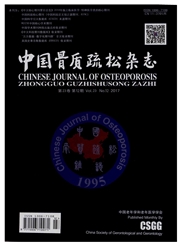

 中文摘要:
中文摘要:
目的先天性成骨不全(0I)的主要临床表现为骨矿化过程不良,骨量丢失,骨骼畸形和骨折。但是其发病机理,尤其在其骨再建过程中成骨细胞(OB)及破骨细胞(OC)的功能改变尚不清楚。本实验以先天性成骨不全小鼠模型,oim/oim为基础,应用破骨细胞一颅骨联合培养体系研究OB和OC两种细胞在骨再建过程中的功能改变和相互作用。方法本实验采用小鼠颅骨(CAL)组织培养模型。本模型采用颅骨组织培养,利用颅骨中成骨细胞可以从颅骨片游离出到培养皿及颅骨表面,从而支持培养皿及颅骨表面前体破骨细胞分化成为成熟破骨细胞,并吸收颅骨产生吸收陷窝。本实验中,共2组颅骨-破骨细胞联合培养体系:(1)对照组(WT)颅骨与对照破骨细胞(WTCAL-WTOC);(2)OI颅骨与OI破骨细胞(OICAL-OIOC)。联合培养颅骨及骨髓组织14日后,以TRAP免疫组化染色方法识别破骨细胞,ALP免疫组化染色方法识别成骨细胞,计算OC/OB。破骨细胞骨吸收活性以颅骨表面骨吸收陷窝占颅骨表面百分比并除以培养系统中的破骨细胞数表达。结果第14日,OICAL-OIOC组的破骨细胞数低于WTCAL.WTOC组(92.50+23.18/mm^2对比379.00+136.53/mm^2,P〈0.01);OICAL-OIOC组的OC/OB明显低于WTCAL-WTOC组(0.68+0.57对比1.650.67,P〈0.01);OICAL-OIOC组0I破骨细胞的吸收能力高于WTCAL—WTOC组(27.76+22.81对比7.32+5.09,P〈0.001)。结论oim/oim小鼠破骨细胞-颅骨培养体系中破骨细胞的数目明显减少,成骨细胞支持破骨细胞分化能力减低;但其破骨细胞骨吸收活性明显增强,以代偿成骨细胞功能,维持骨再建过程中成骨过程及骨吸收过程的平衡。
 英文摘要:
英文摘要:
Objective The major clinical manifestations of osteogenesis imperfecta (OI) includes abnormal bone mineralization, bone mass loss, skeletal deformities, and fractures. However, the pathogenesis of OI, especially the abnormalities in osteoblast (OB) and osteoclast (OC) activity in bone remodeling is not well defined. This paper aimed to explore the functional variation and interaction of OB and OC during the bone remodeling by in vitro OC-Calvaria (CAL) co-culture system in a mouse model of OI, oim/oim. Methods Calvaria culture model was used in this paper. The OBs originated from the calvaria and spread into the culture plate, providing support for differentiation of OC precursors into osteoclasts. Two co-culture systems were used in experiment, including WTCAL-WTOC as control group and OICAL-OIOC as experimental group. OCs was identified using tartrate-resistant acid phosphatase (TRAP) staining and OBs was identified using histochemical assessment of alkaline phosphatase (ALP) staining after 14 days. OC/OB ratio was calculated. The bone absorption activity of OCs was defined using the percentage of absorption pits in the whole calvarial surface. Results The number of OC in the OICAL-OIOC group (92.50± 23.18/mm^2 )were less that that in the WTCAL-WTOC (379.00± 136.53/mm^2) group after 14 days (P〈0.01). OC/ OB ratio in OICA1,-O1OC group (0.68 ±0.57) was significantly lower than that in the WTCAI,-WTOC group (1.65±0.67, P〈0.01). The bone absorption ability of OCs in the OICAI-O1OC group (27.76±22.81) was significantly higher than that in the WTCA1-WTOC group (7.32± 5.09, P 〈 0. 001 ). Conclusion The number of OCs in OICAL-OIOC group significantly and osteoclastogenesis ability supported by OBs decrease significantly. The absorption ability of OCs in the OICAL-OIOC group increases to compensate the OBs function and to maintain the balance of bone absorption and bone formation during bone remodeling.
 同期刊论文项目
同期刊论文项目
 同项目期刊论文
同项目期刊论文
 期刊信息
期刊信息
